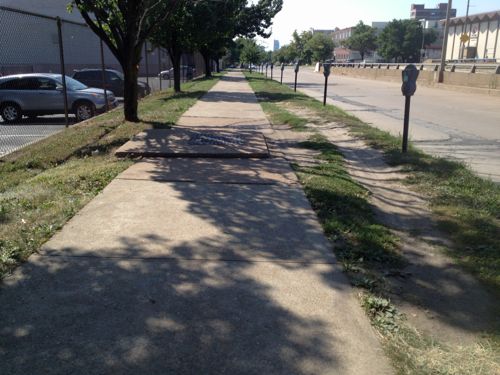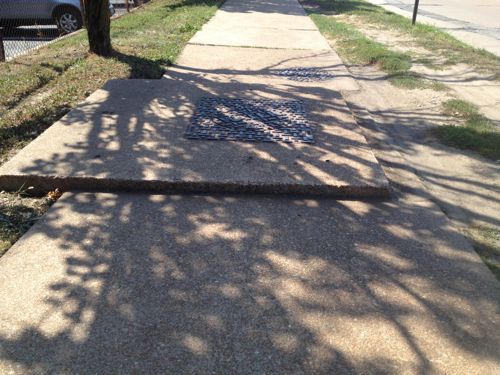One Spot On Sidewalk A Challenge, Who’s Responsible?
I’ve used many sidewalks throughout St. Louis, most are adequate. It just takes one bad point though to made a decent sidewalk barely adequate. That happened to me on Saturday going from Kingshighway to Grand for yesterday’s post. The entire length, over 1.5 miles, was good until I was almost at Grand.


I see these often, I think they’re lids for vaults. Everyone I’ve encountered are raised above the adjacent sidewalk. Who’s responsible? The City? MSD (Metropolitan Sewer District)? The adjacent property owner, Saint Louis University? I haven’t a clue, but I’ll email this post to a few people and find out.
— Steve Patterson
It don’t look like this is anything more than one of the day to day annoyances that all of us have to put up with every day. It’s difficult to not feel annoyed when we are walking downtown and find out unexpectedly that our side of the sidewalk has been closed due to construction and that we will have to either walk in the street or move to the other side to avoid the obstacle. And I imagine that it is even more annoying for someone in a wheel chair, but these things are not done in malicious manner, so why spend unnecessary time money and effort on such trivial issues when there are so many other more important issues out there. In this case what would you expect the city to do? Spend badly needed city funds to redesign a vault cover that only affects a very few people, or perhaps build a bridge over the obstacle so that you don’t have to move off of your path? Or perhaps instead, you can do what so many others seem to do, which is go around the obstacle and get on with your life? I don’t mean to dump on you as I don’t know you, but you tend to come off like the many naysayers that always seem to show up at my project meetings. These are the people that tend to not see the overall big project picture, but concentrate on the minute detail and end up costing more time and money than the issues are worth. They also seldom show up with workable alternative ideas but feel fee to criticize every little detail. There is a fine line between being a naysayer and a contributor and I have often found that I need to keep my mouth shut unless I have a suggestion worth offering. So with this in mind before you contact anyone about this problem, have you thought out a solution and how this can be paid for, and whether or not it is worth doing in light of all the rest of the cities priorities?
If the new retail gets built to the west this will be the main sidewalk students use, hopefully someone will consider the full route to/from.
I’m willing to bet the answer lies with whatever is stamped on the manhole cover. I know the City has the 50/50 program and that certainly helps property owners maintain their sidewalks, but unfortunately there are far more sidewalks than either property owners or the City can maintain. On the plus side, at least in the City has sidewalks.
St. Louis Water.
It’s (almost) obvious (based on the close up) that the sidewalk has settled around the vault lid. (Can’t see the interfacing joint between the lid and the sidewalk to be sure.) No one in his right mind would deliberately pour concrete and leave it looking like this, creating a hazard to both disabled and abled pedestrians.. It is likely that the sidewalk is settling because of some washout action at or around the vault, undermining the sidewalk. Looking at the change in sidewalk color and texture in the background suggests this same thing may have happened sometime in the past, depending on the age of the vault. If there is washout/undermining at the vault, then the vault owner is LIKELY responsible for the repair (POSSIBLY poor backfill design). The only way to determine responsibility is to remove the concrete sidewalk, then dig out the subgrade to determine where the water is traveling. That will establish guilt!. Or a waterproofing material injected around the vault (perhaps Bentonite) MIGHT stop the erosion, and that’s where I’d place my bet! (cheaper, too!) Sometimes it takes longer to determine responsibility than it does to make the repair. A decent 3 man crew with a backhoe can have this repaired in less than 2 days. And it might be prudent and less costly in the long run if the owner of the sidewalk (?) and the owner of the vault (?) just decided to split the repair costs.
I don’t think the sidewalk settled, I encounter these lids all the time, I think they were installed like this.
I would find it incredible to learn that the vault and adjacent sidewalk were poured at different finish elevations. But if this is not the case, the sidewalk didn’t settle “uniformly”around the vault without good reason. There has to be a void in the vault backfill, where the water is conduiting the sidewalk subgrade and escaping., leaving a void. (Can’t tell if the exposed aggregate-looking sidewalk “ramps” “down” from the original sidewalk elevation to where it meets the vault lid. If so, then I would place my bet on “settlement”!). Unless there is some other strange settlement action going on at some adjacent area, the LIKELY source of the problem is the vault backfill.
If for some strange reason the vault lid was deliberately and originally poured at a higher elevation than the adjacent sidewalks, then a civil engineer who received his diploma and registration by correspondence course was definitely involved! It would make no sense to do what you suggest might have been done. Period.
Streets director Todd Waelterman just got back to me, he too thinks the sidewalk sunk. He’s asked a staff person to check with Water Dept to see if they can do anything. If not, they’ll use a bit of asphalt on each side to help out.
hoosier solution
An excellent solution given limited resources. I’d rather be able to get by today rather than wait years fir the ideal fix.
Then let’s do this at every intersection that lacks a curb ramp!
Big difference between this lip and a curb.
How so? 2″ or 3″ vs. 6″ or 8″?
A barrier is just that – it forces a detour or ends the trip before it can be completed. We have multiple barriers, throughout the city, and limited funds to fix them all. If cheap and ugly is good enough here, because the alternative is waiting years for the proper solution, then why isn’t cheap and ugly good enough for fixing a few hundred or a few thousand inaccessible intersections THIS YEAR, as well?! A patch is a patch – it doesn’t matter if it’s mid block or at the corner!
The only difference is that the asphalt would protrude into the roadway, thereby shortening it’s life. But I have to agree with JZ….seems to be a double standard….accepting a temporary patch but yet this attitude has been missing in previous posts regarding sidewalks.
If this were installed 3 months ago I would object to an asphalt patch. Given that it isn’t new, the city has unfortunately accepted the work, it needs to be made passable sooner rather than later. In the meantime it needs to somehow be flagged for proper fixing in the future.
I agree….3 months or even a year is quite a different matter. But again, just like JZ suggested…why not asphalt all the sidewalk ramps? They’ve been there for years and have been “accepted” by both the city and the users. Don’t get me wrong, I get what you’re saying…but with limited resources….not every sidewalk can be tended to ASAP as you have frequently pointed out. So if it’s acceptable here, why not elsewhere?
I will almost guarantee you that if this “temporary” fix gets done in the next ten days, it will still be the only fix two years from now, and probably five years from now . . . http://failblog.cheezburger.com/thereifixedit
We need to 1) make sure the people we’re hiring to do work do a good job so we don’t end up with avoidable & costly mistakes that need fixing down the road. 2) Determine the issues ward by ward so some capital money can be used each year.
First, I agree that an asphalt transition is a hoosier solution. Both in appearance and in performance. You cannot “feather” asphalt (at its low point where it meets the concrete sidewalk) without soon seeing some asphalt-surface degradation, which will eventually allow water to undermine the patch, resulting in spauling; then entire sections of asphalt will dislodge and collect as crumbled petroleum (black bituminous) covered aggregate scattered around the concrete sidewalk. And as far as making sure that contracted (and city-performed) work is done properly, we can do only so much. Settlement issues can result even if the compaction is tested-at-placement (as it should be but often isn’t) at 97% modified p. Short of that, backfill can be placed in 8 to 12″ lifts (depending on the backfill material type) and hand compacted. But done properly using either method, we have no control over subsoil conditions beyond the excavation which might impact our backfill. The Water Division can do something without spending a fortune. They can inject Bentonite, then after the bentonite has set up, inject a slurry of lightweight concrete around the transition to raise (pump up) the elevation of the sidewalk to meet the vault lid. City Streets has the equipment on hand to address accordingly.
Spell check can’t recognize “hoosier” (w/lower case ‘h’). (????)
But it could be the vault didn’t settle but the sidewalk did. As I said, these are a very common problem I encounter so I’d like to make sure something is done differently in the future.
Steve seems to have gotten the answer – it’s a classic coordination problem between the Street Department and the Water Division. The only way city departments know about these kinds of problems is if somebody complains – there’s no way for them to get out there and walk every section of sidewalk all the time. At least then it gets on the list for repair though.
(It was a similar situation when I had a lifted up section of sidewalk in front of my house due to a street tree – eventually it got fixed when I complained to the alderman, and I paid nothing even though it was my property. Coordination between Streets and Forestry is needed in that case.)
Just interviewed about this, should be on the 10 pm news tonight (KMOV-4).